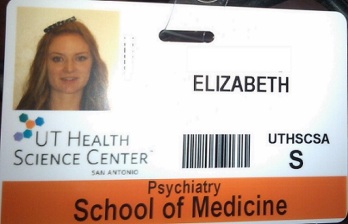In preparation for a Summer Research Internship, the UROC Scholar Seminar Series at CSUMB provided training on how to effectively manage relationships in laboratory environments. After rehearsing unusual but commonly occurring situations that may arise between students and faculty, I came to UTHSCSA ready for many variants in relationships, hierarchies, and organizational structures within the laboratory. For instance, I might be on a team of multiple undergraduates, perhaps even high school students. I could work side by side with a graduate student on a particular project. I may be extremely limited in interaction with the primary investigator (PI) seldom seeing them or the graduate students. On the contrary I might work directly with the PI at this site. I might share a desk on a top floor in an open-office floor plan, or be secluded to my own office tucked down below the ground level in a basement lab with little to no interaction with other students or faculty.
UTHSCSA is unlike other summer research internship sites in that it is not a liberal arts university, although it is an extension of the University of Texas system. UTHSCSA is a medical school with more than 100 affiliate hospitals, clinics, and health care facilities. My research placement is taking place in The Neurobehavioral Research Laboratory and Clinic (NRLC) which is a division within the UTHSCSA Psychiatry Department. The NRLC is unique; composed of a multi-disciplinary team of researchers. A difference in the medical school setting is that many of the researchers are paid technicians rather than students. This means that there would be no graduate students, and aside from other NIDA Summer Research Internship students, there would be no undergraduate students besides myself.
Often times a singular perspective may experience opposition from other perspectives, causing tension within the scientific community. What came first; the chicken, or the egg? “Neither” nor “both” are not acceptable answers to this inquiry. Particularly within America there is a dominant argumentation culture. To make progress or prove information to be true or give it value, there needs to be an assertion for what is right, more right, and that any alternates are wrong. One can trace back the origin of this culture to the roots of knowledge; acquiring truths, facts, and principles from investigation. Investigation requires scrutiny and exploration of an idea. Terminology must be defined, and hypotheses need to be disputed to be proven incorrect, in order to be accepted as true. While these core concepts may be necessary for the attainment of knowledge, especially in scholarly settings, the processes by which argumentation takes place are not limited to debate. Productive argumentation across multiple disciplines and for the purpose of research consists of establishing similarities. Acknowledging similarities engages alternate sides of the topic, allowing them to form mutual goals. It is becoming increasingly clear that understanding today’s problems and discovering tomorrow’s solutions will require the cultivation of scientists with varying and often contrasting research backgrounds, perspectives, concepts, and theories from an array of scientific fields. The contemporary approach in the scientific community is showing interest and appreciation for a diverse population of researchers and perspectives when engaging in scholarly discussions and in designing research studies, and analyzing data.
Here at NRLC, Drs. Donald Dougherty, Charles Mathias, and Ashley Acheson have been running an on-going longitudinal study. Dr. Dougherty is the Director of the NRLC as well as the Deputy Chair for Research in the Department of Psychiatry. He focuses on studying impulsive behavior in association to drug abuse and suicide. Part of his research includes identifying biological and behavioral risk factors for psychopathy. Dr. Acheson is an Assistant Professor in the Department of Psychiatry as well as the Research Imaging Center at UTHSCSA. He is trained in studying laboratory models of decision-making and impulse control in both rodents and humans. He specializes in examining neural differences in adolescents at risk for developing substance use disorders. Dr. Mathias is also an Associate Professor within the Department of Psychiatry. His research approach adapts laboratory behavioral procedures including psychophysiological measurements to assess impulsivity. This approach reveals physiological mechanisms that underlie behaviors among individuals with psychiatric symptoms and disorders. While their backgrounds and expertise are varied, bringing together these perspectives results in more powerful advances in science.
In addition to the primary investigators listed above, and other NRLC faculty, there are several post-doctorate fellows and staff making up the NRLC team. While there are not graduate students per say, having people with these varying levels of academic training and research experience really make for a rich and diverse training environment. Each person has a specific focus area and brings these approaches and their unique experiences and ideas to the table. This allows for an inclusion of different fields simultaneously when discussing one idea, or conducting one study. Participants’ experiences and time, and collected data are efficiently collected and analyzed this way. The NRLC truly is an interdisciplinary community.




